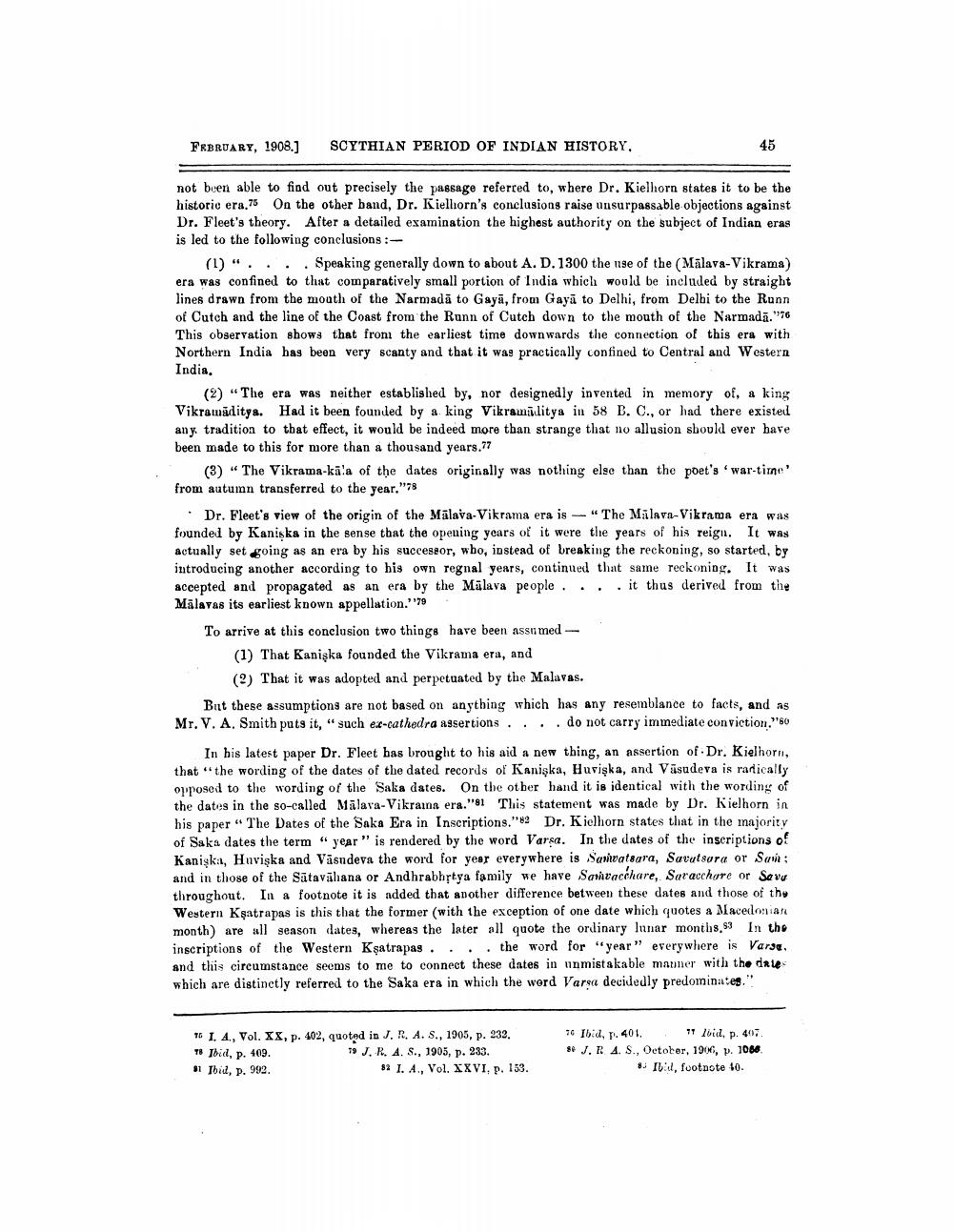________________
FRBRUARY, 1908.)
SCYTHIAN PERIOD OF INDIAN HISTORY,
45
not been able to find out precisely the passage referred to, where Dr. Kielhorn states it to be the historic era.75 On the other band, Dr. Kiellorn's conclusions raise unsurpassable objections against Dr. Fleet's theory. After a detailed examination the highest authority on the subject of Indian eras is led to the following conclusions :
(1) "....Speaking generally down to about A. D. 1300 the use of the Mālava-Vikrama) era was confined to that comparatively small portion of India which would be included by straight lines drawn from the mouth of the Narmadā to Gayā, from Gayā to Delhi, from Delbi to the Runn of Cutch and the line of the Coast from the Runn of Cutch down to the mouth of the Narmadā."76 This observation shows that from the earliest time downwards the connection of this era with Northern India has been very scanty and that it was practically confined to Central and Western India,
(2) “The era was neither established by, nor designedly invented in memory of, a king Vikramaditya. Had it been founded by a king Vikramīditya in 58 B. C., or had there existed any tradition to that effect, it would be indeed more than strange that no allusion should ever have been made to this for more than a thousand years.77
(3) “The Vikrama-kala of the dates originally was nothing else than the poet's war-time' from autumn transferred to the year,"78
Dr. Fleet's view of the origin of the Mālava-Vikrama era is - "The Malava-Vikrama era was founded by Kaniska in the sense that the opening years of it were the years of his reign. It was actually set going as an era by his successor, who, instead of breaking the reckoning, so started, by introducing another according to his own regnal years, continued that same reckoning. It was accepted and propagated as an era by the Mülava people. ... it thus derived from the Mālavas its earliest known appellation.'70 . To arrive at this conclusion two things have been assumed -
(1) That Kaniska founded the Vikrama era, and
(9) That it was adopted and perpetuated by the Malavas. But these assumptions are not based on anything which has any resemblance to facts, and as Mr. V. A. Smith puts it, "such exc-cathedra assertions .... do not carry immediate conviction."0
In his latest paper Dr. Fleet has brought to his aid a new thing, an assertion of Dr. Kielhorn, that the wording of the dates of the dated records of Kaniska, Huviska, and Visudeva is radically opposed to the wording of the Saka dates. On the other hand it is identical with the wording of the dates in the so-called Mālava-Vikrama era."91 This statement was made by Dr. Kielhorn in his paper "The Dates of the Saka Era in Inscriptions."2 Dr. Kielhorn states that in the majority of Saka dates the term "year" is rendered by the word Varsa. In the dates of the inscriptions of Kaniska, Huviska and Väsndeva the word for year everywhere is Sarivatsara, Savutsora or San: and in those of the Sātavāhana or Andhrabhstya family we have Sarracéhare, Saracchere or Seve throughout. In a footnote it is added that another difference between these dates and those of thy Western Kşatrapas is this that the former (with the exception of one date which quotes a Macedonian month) are all season dates, whereas the later all quote the ordinary lunar months. In the inscriptions of the Western Ksatrapas. ... the word for "year" everywhere is Varse, and this circumstance seems to me to connect these dates in unmistakable manner with the date which are distinctly referred to the Saka era in which the word Varsa decidedly predominates."
16 1. A., Vol. XX, p. 402, quoted in J.R. A. S., 1905, p. 232. 78 Jbid, p. 409.
19 J. R. A. S., 1905, p. 233. 1 Ibid, p. 992.
$2 I. A., Vol. XXVI. p. 153.
76 Ibid, p. 401. 11 lvid, p. 407. St J.R A. S., October, 1906, p. 1086
8. Id, footnote 10.




